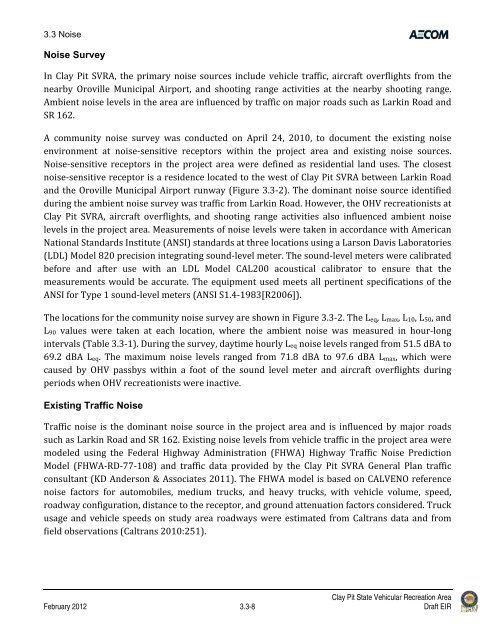Draft Environmental Impact Report - California Off Highway Vehicle ...
Draft Environmental Impact Report - California Off Highway Vehicle ...
Draft Environmental Impact Report - California Off Highway Vehicle ...
Create successful ePaper yourself
Turn your PDF publications into a flip-book with our unique Google optimized e-Paper software.
3.3 Noise<br />
Noise Survey<br />
In Clay Pit SVRA, the primary noise sources include vehicle traffic, aircraft overflights from the<br />
nearby Oroville Municipal Airport, and shooting range activities at the nearby shooting range.<br />
Ambient noise levels in the area are influenced by traffic on major roads such as Larkin Road and<br />
SR 162.<br />
A community noise survey was conducted on April 24, 2010, to document the existing noise<br />
environment at noise‐sensitive receptors within the project area and existing noise sources.<br />
Noise‐sensitive receptors in the project area were defined as residential land uses. The closest<br />
noise‐sensitive receptor is a residence located to the west of Clay Pit SVRA between Larkin Road<br />
and the Oroville Municipal Airport runway (Figure 3.3‐2). The dominant noise source identified<br />
during the ambient noise survey was traffic from Larkin Road. However, the OHV recreationists at<br />
Clay Pit SVRA, aircraft overflights, and shooting range activities also influenced ambient noise<br />
levels in the project area. Measurements of noise levels were taken in accordance with American<br />
National Standards Institute (ANSI) standards at three locations using a Larson Davis Laboratories<br />
(LDL) Model 820 precision integrating sound‐level meter. The sound‐level meters were calibrated<br />
before and after use with an LDL Model CAL200 acoustical calibrator to ensure that the<br />
measurements would be accurate. The equipment used meets all pertinent specifications of the<br />
ANSI for Type 1 sound‐level meters (ANSI S1.4‐1983[R2006]).<br />
The locations for the community noise survey are shown in Figure 3.3‐2. The Leq, Lmax, L10, L50, and<br />
L90 values were taken at each location, where the ambient noise was measured in hour‐long<br />
intervals (Table 3.3‐1). During the survey, daytime hourly Leq noise levels ranged from 51.5 dBA to<br />
69.2 dBA Leq. The maximum noise levels ranged from 71.8 dBA to 97.6 dBA Lmax, which were<br />
caused by OHV passbys within a foot of the sound level meter and aircraft overflights during<br />
periods when OHV recreationists were inactive.<br />
Existing Traffic Noise<br />
Traffic noise is the dominant noise source in the project area and is influenced by major roads<br />
such as Larkin Road and SR 162. Existing noise levels from vehicle traffic in the project area were<br />
modeled using the Federal <strong>Highway</strong> Administration (FHWA) <strong>Highway</strong> Traffic Noise Prediction<br />
Model (FHWA‐RD‐77‐108) and traffic data provided by the Clay Pit SVRA General Plan traffic<br />
consultant (KD Anderson & Associates 2011). The FHWA model is based on CALVENO reference<br />
noise factors for automobiles, medium trucks, and heavy trucks, with vehicle volume, speed,<br />
roadway configuration, distance to the receptor, and ground attenuation factors considered. Truck<br />
usage and vehicle speeds on study area roadways were estimated from Caltrans data and from<br />
field observations (Caltrans 2010:251).<br />
Clay Pit State Vehicular Recreation Area<br />
February 2012 3.3-8 <strong>Draft</strong> EIR








